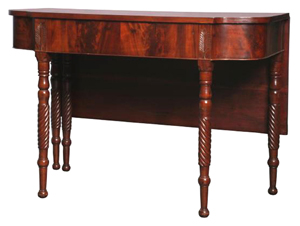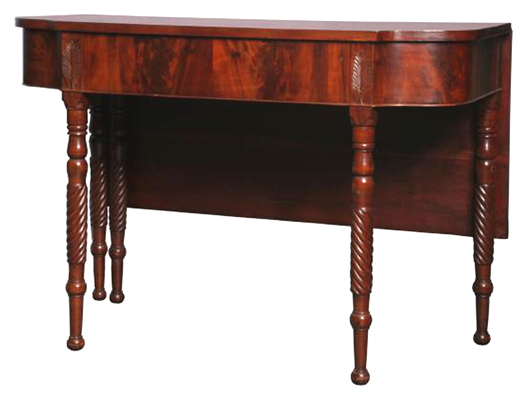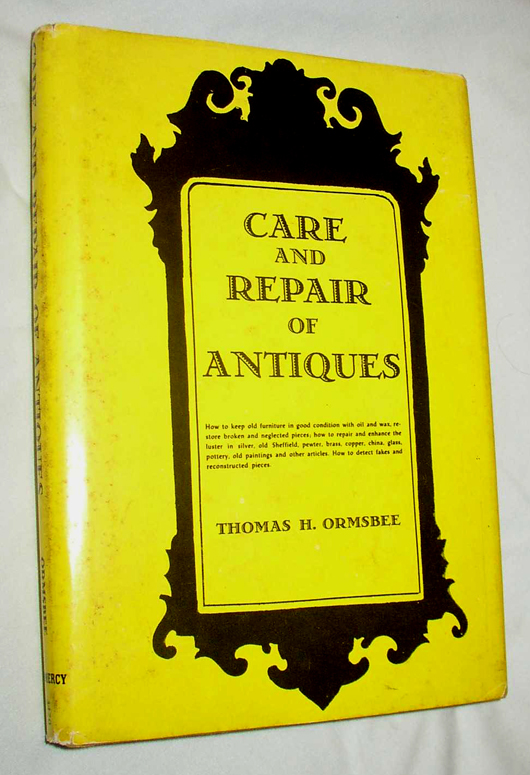
CRYSTAL RIVER, Fla. – A few weeks ago my public library board had their annual deaccession sale. They didn’t call it that but it was. We trekked over to the county seat to the fairgrounds auditorium for a quick stroll through thousands of volumes arranged on folding tables and sorted not by the arcane Dewey decimal system but by meaningful categories like Archaeology and Cooking. How refreshing from a library system.
After lusting over the 30-volume “boxed sets” about the Civil War, World War I and World War II, I wandered over to the “Antique Furniture” section. It had three forlorn orphaned books in a dusty cardboard box (I already had two of the titles). I am a sucker for orphaned books like some folks collect tools or puppies, and I’m also a real bargain hunter, driven more by price than value, I hate to admit. One slender bold yellow and black hardback edition caught my eye with the ambitious title of Care and Repair of Antiques. It was an especially ambitious undertaking to cover such a complicated subject in a mere 168 pages. The price was $1. For a buck I will save almost any volume from Fahrenheit 451, no mater how ambitious.
A few days later I had time to devote to my new acquisition and I was pleasantly surprised. The work was authored by Thomas H. Ormsbee, who authored a number of serious volumes on antique furniture in the 1940s and 1950s. This one was published in 1949 by Grammercy and each chapter was originally published as a freestanding article in The Magazine Antiques.
Since the book and I could be brothers given our dates of birth (not saying which came first) I thought it would be interesting to see how the current view of antiques in general and furniture in particular has changed in my lifetime. While some of the changes were striking and in many cases would be considered “sinful” by today’s standards, some of the basics, as in any field, never change, only the interpretation.
One of the most striking changes is pointed out before the book even begins. The inside fly written by the author says, “In a recent survey made at leading antique shows, the book most frequently called for by the public, and not hitherto available, is one on the subject of caring for and renovating antiques.” Remember, this was 1949, the war was just over and the world was just beginning again. It called for an entirely different mind set. In the last round of shows I attended I made it a point to ask book dealers what was selling, an obvious move of self-interest because many of them carry my book. I was only slightly surprised to hear that the top-selling books, as had been the case for the last few years, were the price guides. It didn’t matter by whom, the subject matter, the credibility or the price of the guide. If it was a price guide it sold. Apparently in today’s market “How do I take care of it?” has been replaced by “What’s it worth?”
But the single most striking example of a change in thought was in the renovation of antique furniture. For modern collectors and owners the Antiques Roadshow and the effervescent Keno brothers have beaten us about the head and shoulders so severely about disturbing an original finish that many people are fearful of wiping off the dust on a mid-century modern bookcase for fear of “losing the value.” That attitude is slowly changing regarding most 20th century pieces but it is still there. I get a reader’s question almost every day about losing the antique value by repairing the damaged finish on a Depression-era bedroom set. Ormsbee on the other hand had no qualms about stripping a piece.
Two thirds of the way through the book Ormsbee states, “The nearer a piece can be kept to its original condition, the better.” He then proceeds to tell you how to strip and refinish the piece, including his favorite method using a gasoline torch, while giving a short lesson on the rare cases when a finish can and should be preserved.
This is where the most startling difference in 60 years shows itself. He starts with a process he says museum curators call “feeding.” After cleaning a piece with carbon tetrachloride, which is no longer used because of greenhouse gasses (odorless mineral spirits or Vulpex soap is the modern preference), the piece is coated generously with heated raw linseed oil and left to stand three or four days while the oil is absorbed, feeding the old finish and the wood below. It is then wiped down and re-oiled at least two more times and as many as five more times. After the piece is wiped down the last time it can then be recoated with the original finish, shellac or oil-based varnish.
There is more than one problem in that process that has been exposed by modern research, thoroughly and eloquently explained by Robert Flexner in his excellent work on the subject Understanding Wood Finishing published by Reader’s Digest.
The first problem is that the oil is not absorbed by the old finish nor the wood. Some of it evaporates and the rest of it simply dries as a thin soft skin over the original finish. After wax the softest thing you can use as a finish is linseed oil. The original finish is designed to prevent such absorption of a liquid of any sort and even if the finish is not intact the oil will not penetrate much deeper than the first cellular layer. The capillary action of the wood will not conduct such a viscous liquid. The museum curator who thought he was feeding the finish or the wood has less than a complete understanding of the chemistry of film finishes or activity of dead wood since neither substance needs to be “fed.”
Another problem with that procedure, as we now know, is that linseed oil is in fact a drying oil. It is not absorbed into the wood. Some portion of it remains on the surface. It will eventually try to integrate itself into both the original finish below it and the additional finish on top of it. In the future it will start to “crawl” and create cracks in both layers of finish and then it will have to be stripped.
However, Ormsbee does follow modern thinking in the aftercare of cured finishes. He shuns the use of any kind of oil as a dressing for all the right reasons. He advocates the use of a paste wax and shows he is years ahead of his time in which wax to use. Eschewing the use of commercially prepared waxes that have a petroleum base, he makes his own by shaving a pound of solid beeswax into a wide-mouth jar and filled halfway with turpentine. It is then placed in the sun until the wax melts and the solution more or less solidifies. He claims a quart of this mixture will do many pieces of furniture. No doubt.
Despite these apparent differences with modern philosophy, it appears that the basic concepts remain the same. The same recognition factors in identifying antique furniture are discussed including the evolution of fasteners, the clues left by tool marks and the basics of joinery identification.
While the basics are the same however, the devil is in the details. The difference in the breadth and depth of knowledge between the collectors of the late 1940s and those of the early 21st century is remarkable, thanks in large part to the free flow of information afforded by trade publications such as this one and the ever-present 600-pound gorilla in the room, the Internet.
Send comments, questions and pictures to Fred Taylor at P.O. Box 215, Crystal River, FL 34423 or email them to him at info@furnituredetective.com.
Visit Fred’s website at www.furnituredetective.com. His book How To Be a Furniture Detective is available for $18.95 plus $3 shipping. Send check or money order for $21.95 to Fred Taylor, P.O. Box 215, Crystal River, FL, 34423.
Fred and Gail Taylor’s DVD, Identification of Older & Antique Furniture ($17 + $3 S&H) is also available at the same address. For more information call 800-387-6377, fax 352-563-2916, or info@furnituredetective.com. All items are also available directly from his website.

ADDITIONAL IMAGE OF NOTE



